嵌入式小波零树(EZW)算法的过程详解和 Matlab 代码(3)解码过程 收藏
1、初始化
(1)全局初始化:包括获取扫描次序列表 scanorder,初始化符号矩阵 flagMat,创建以下几
个空表:重要系数重构列表 recvalue,量化器编号列表 rIlist,上一次解码用到的辅扫描表 qu
antiflagOld。
(2)每级扫描的初始化:获取本级解码需要的主扫描表 scancode 和辅扫描表 quantiflag。创
建解码矩阵 DecodeMat,量化符号列表编号 qrNum,主扫描表扫描编号 scNum。
2、构造逆量化器
(1)逆量化器包括两个部分,一是量化值部分,与编码程序中的量化器函数代码相同;二是量
化器编号列表 rIlist 的构造,这个是难点和重点,把它构造出来,才能解码出重要系数的数值。
(2)以下是编码过程中经过 4 次扫描产生的辅扫描表 quantiflag 和量化器编号列表 rIlist:
Q:0 1 1
R:1 1 1
Q:1 1 1 1 0 0 0 1 1 0
R:2 3 3 1 1 1 1 1 1 1
Q:1 0 1 1 0 1 0 0 1 0 0 1 1 0 0 1 1 0 0 0 1 0 1 0 1 0 0 1 0 1 0 1 1 0 0
0 1 1 0
R:5 7 7 3 2 2 2 3 3 2 1 1 1 1 1 1 1 1 1 1 1 1 1 1 1 1 1 1 1 1 1 1 1 1 1
1 1 1 1
Q:0 1 1 1 0 0 1 0 0 1 1 0 0 0 1 0 0 1 1 1 1 0 0 1 0 0 1 0 1 0 1 1 1 0 0
0 0 0 1 0 1 1 0 0 1 0 1 0 0 1 1 0 0 1……
R:11 14 15 7 4 5 4 6 7 4 2 3 3 2 2 3 3 2 2 2 3 2 3 2 3 2 2 3 2 3 2 3 3 2
2 2 3 3 2 1 1 1 1 1 1 1 1 1 1 1 1 1 1 1……
仔细观察可以发现两者之间存在一种函数关系:
以第一级扫描产生的三个量化符号(0,1,1)为例,其编号列表为(1,1,1),在随后的第
�
2、3、4 级分解后,量化符号相继变化为(1,1,1)、(1,0,1)、(0,1,1),编号列
表相继变化为(2,3,3)、(5,7,7)、(11,14,15),这里有一个规律:
(2,3,3)
= 2*(1,1,1)+(0,1,1)
(5,7,7)
= 2*(2,3,3)+(1,1,1)
(11,14,15)= 2*(5,7,7)+(1,0,1)
这样,我们就得到如下公式:
设 r 表示扫描级数,则有: rIlist(r) = 2*rIlist(r-1) + quantiflag(r-1)
从而,就可以轻松编写出逆量化器的函数代码:
function [antiQuantiMat,rIlist,quantiflagOld]=antiquantifier(T1,level,rIlist,quantifl
ag,quantiflagOld)
antiQuantiMat=[];
maxInterValue=2*T1;
threshold=T1/2^(level-1);
intervalNum=maxInterValue/threshold-1;
for i=1:intervalNum
antiQuantiMat=[antiQuantiMat;threshold*(i+0.25) threshold*(i+0.75)];
end
rIlen=length(rIlist);
flaglen=length(quantiflag);
for r=1:rIlen
rIlist(r)=2*rIlist(r)+quantiflagOld(r);
end
for f=rIlen+1:flaglen
rIlist(f)=1;
end
quantiflagOld=quantiflag;
�
3、提高上一级解码的重要系数的重构精度
这里主要是根据逆量化器生成的重构值矩阵 antiQuantiMat 和逆量化器编号列表 rIlist 来更新
重要系数列表 recvalue 的值,并将更新数据存入解码矩阵 DecodeMat 中。这四个矩阵(列表)
的每一行(个)元素都是一一对应的关系,更新就很容易实现,代码如下:
function [DecodeMat,recvalue,qrNum]=updateRecvalue(DecodeMat,recvalue,qrN
um,quantiflag,antiQuantiMat,rIlist)
if ~isempty(recvalue)
[rvRow,rvCol]=size(recvalue);
for i=1:rvRow
if quantiflag(qrNum)==1
qValue=antiQuantiMat(rIlist(qrNum),2);
if recvalue(i)<0
qValue=-qValue;
end
recvalue(i,1)=qValue;
DecodeMat(recvalue(i,2),recvalue(i,3))=qValue;
qrNum=qrNum+1; % recvalue 矩阵的第 2、3 列储存的是对应于 DecodeMa
t 中的行、列号(r,c)
else
qValue=antiQuantiMat(rIlist(qrNum),1);
if recvalue(i)<0
qValue=-qValue;
end
recvalue(i,1)=qValue;
DecodeMat(recvalue(i,2),recvalue(i,3))=qValue;
qrNum=qrNum+1;
end
end
end
�
4、解码
解码过程其实与主扫描过程非常类似,按照扫描次序 scanorder 扫描解码矩阵 DecodeMat:
(1) 首先检查对应的 flagMat 是否为“O”或“X”,是则跳过,扫描下一个元素。
(2) 然后对照主扫描表 scancode,作如下操作:
如果为“P”或“N”,则更新 flagMat,根据逆量化器重构 DecodeMat 相应元素的值,并存入重
要系数矩阵 recvalue 中;
如果为“Z”,则 DecodeMat 相应元素的值置零;
如果为“T”,则更新 flagMat,DecodeMat 相应元素的值置零,并使该点所有子孙的 flagMat
置为“X”。
(3)本级解码完毕,保存符号矩阵 flagMat 到解码符号矩阵 Decodeflag 中,然后使 flagMat
中的元素重置为“O”或“Z”,供下一级解码使用。
function [DecodeMat,flagMat,recvalue]=decoding(DecodeMat,flagMat,recvalue,an
tiQuantiMat,quantiflag,rIlist,scanorder,scancode,scNum,qrNum)
global row col
for r=1:row*col
if flagMat(scanorder(r,1),scanorder(r,2))=='O'
continue;
elseif flagMat(scanorder(r,1),scanorder(r,2))=='X'
continue;
else
if scancode(scNum)=='P'
flagMat(scanorder(r,1),scanorder(r,2))='P';
if quantiflag(qrNum)==1
qValue=antiQuantiMat(rIlist(qrNum),2);
recvalue=[recvalue;qValue,scanorder(r,1),scanorder(r,2)];
DecodeMat(scanorder(r,1),scanorder(r,2))=qValue;
qrNum=qrNum+1;
else
qValue=antiQuantiMat(rIlist(qrNum),1);
�
recvalue=[recvalue;qValue,scanorder(r,1),scanorder(r,2)];
DecodeMat(scanorder(r,1),scanorder(r,2))=qValue;
qrNum=qrNum+1;
end
scNum=scNum+1;
elseif scancode(scNum)=='N'
flagMat(scanorder(r,1),scanorder(r,2))='N';
if quantiflag(qrNum)==1
qValue=-antiQuantiMat(rIlist(qrNum),2);
recvalue=[recvalue;qValue,scanorder(r,1),scanorder(r,2)];
DecodeMat(scanorder(r,1),scanorder(r,2))=qValue;
qrNum=qrNum+1;
else
qValue=-antiQuantiMat(rIlist(qrNum),1);
recvalue=[recvalue;qValue,scanorder(r,1),scanorder(r,2)];
DecodeMat(scanorder(r,1),scanorder(r,2))=qValue;
qrNum=qrNum+1;
end
scNum=scNum+1;
elseif scancode(scNum)=='Z'
DecodeMat(scanorder(r,1),scanorder(r,2))=0;
scNum=scNum+1;
elseif scancode(scNum)=='T'
flagMat(scanorder(r,1),scanorder(r,2))='T';
DecodeMat(scanorder(r,1),scanorder(r,2))=0;
chTree=treeMat(scanorder(r,1),scanorder(r,2));
[rowch,colch]=size(chTree);
for rc=1:rowch
if flagMat(chTree(rc,1),chTree(rc,2))~='O'
flagMat(chTree(rc,1),chTree(rc,2))='X';
�
end
end
scNum=scNum+1;
end
end
end
Decodeflag=flagMat;
for i=1:row
for j=1:col
switch flagMat(i,j)
case {'P','N'}
flagMat(i,j)='O';
case {'T','X'}
flagMat(i,j)='Z';
end
end
end
嵌入式小波零树(EZW)算法的过程详解和 Matlab 代码(4)运行示例 收藏
最后,我们以一幅 64*64 的 Lena 局部图像来演示 EZW 算法的编解码效果。
首先给出相关的编解码主程序。
function y=ezw(Im,imDim,codeDim,DecodeDim)
global row col
[row,col]=size(Im);
% ----- Wavedec -----%
DecIm=mywavedec2(Im,imDim);
% ----- Select threshold -----%
MaxDecIm=max(max(abs(DecIm)));
T=zeros(1,codeDim);
�
T(1)=2^flor(log2(MaxDecIm));
for i=2:codeDim
T(i)=T(i-1)/2;
end
% ----- EZW coding -----%
[CodeList,LenSubCL,QuantiFlagList,LenSubQFL]=ezwcode(DecIm,T,codeDim);
% ----- EZW decoding -----%
DecodeMat=ezwdecode(DecIm,T(1),DecodeDim,CodeList,LenSubCL,QuantiFlagLis
t,LenSubQFL);
% ----- Waverec -----%
DecIm(1:row/8,1:col/8)
DecodeMat(1:row/8,1:col/8)
RecIm=mywaverec2(DecodeMat,imDim);
function [CodeList,LenSubCL,QuantiFlagList,LenSubQFL]=ezwcode(Mat,threshold,
codedim)
global row col
scanlist=morton(Mat);
flaglist(1:row,1:col)='Z';
imptvalue=[];
imptflag=[];
% ----- Intializing EZW coding output variables -----%
CodeList=[];
LenSubCL=[];
QuantiFlagList=[];
LenSubQFL=[];
% ----- Coding loop -----%
for d=1:codedim
[imptvalue,imptflag,scancode,scanflag,flaglist]=mainscan(Mat,scanlist,flaglist,i
�
mptvalue,imptflag,threshold(d));
[quantilist,quantiflag,recvalue,quantifierMat]=assistscan(imptvalue,d,threshold
(1));
% Produce code dataflow
CodeList=[CodeList,scancode];
LenSubCL=[LenSubCL,length(scancode)];
QuantiFlagList=[QuantiFlagList,quantiflag'];
LenSubQFL=[LenSubQFL,length(quantiflag)];
end
function DecodeMat=ezwdecode(Mat,T1,decodeDim,CodeList,LenSubCL,QuantiFla
gList,LenSubQFL)
global row col
recvalue=[];
rIlist=[];
quantiflagOld=[];
scanorder=listorder(row,col,1,1);
flagMat(1:row,1:col)='Z';
for level=1:decodeDim
scancode=CodeList(1:LenSubCL(level));
CodeList=CodeList(LenSubCL(level)+1:end);
quantiflag=QuantiFlagList(1:LenSubQFL(level));
QuantiFlagList=QuantiFlagList(LenSubQFL(level)+1:end);
DecodeMat=Mat;
qrNum=1;
scNum=1;
�
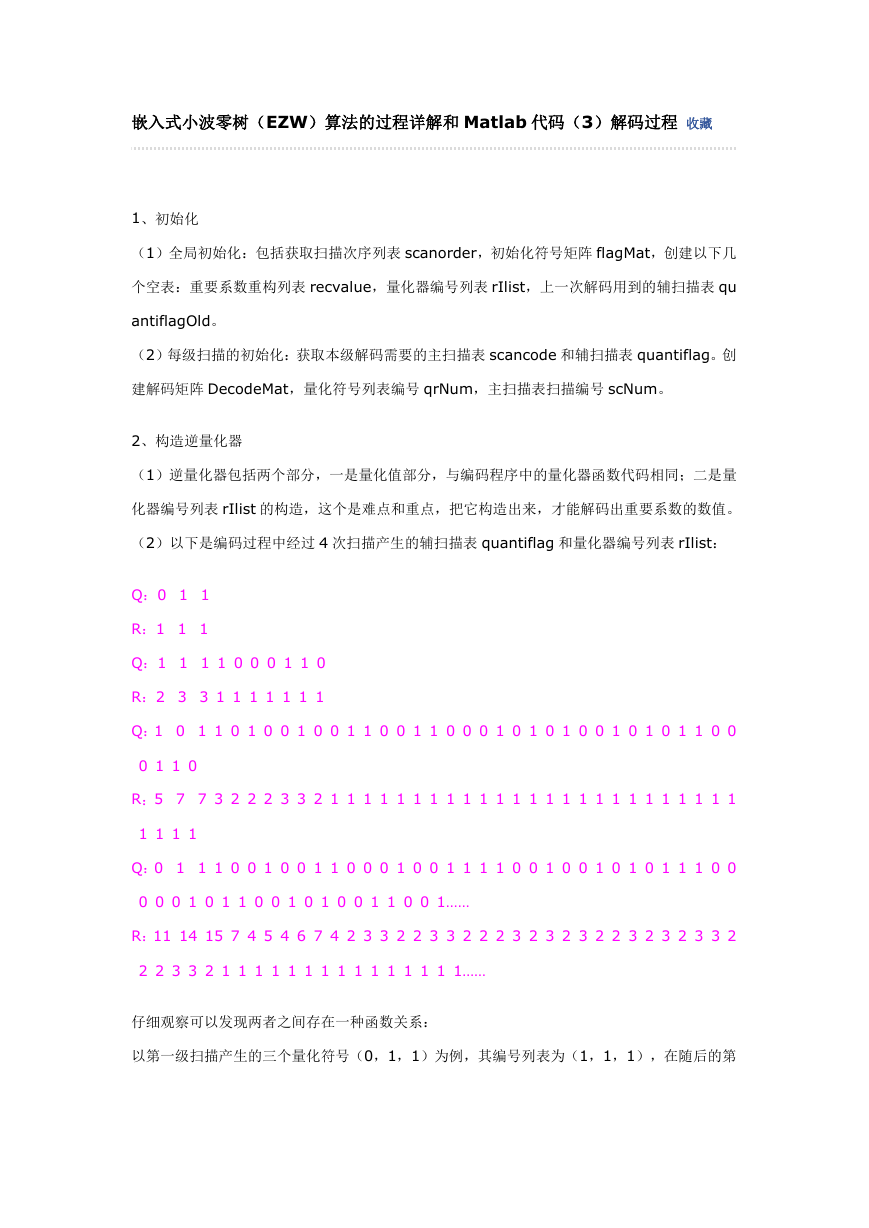
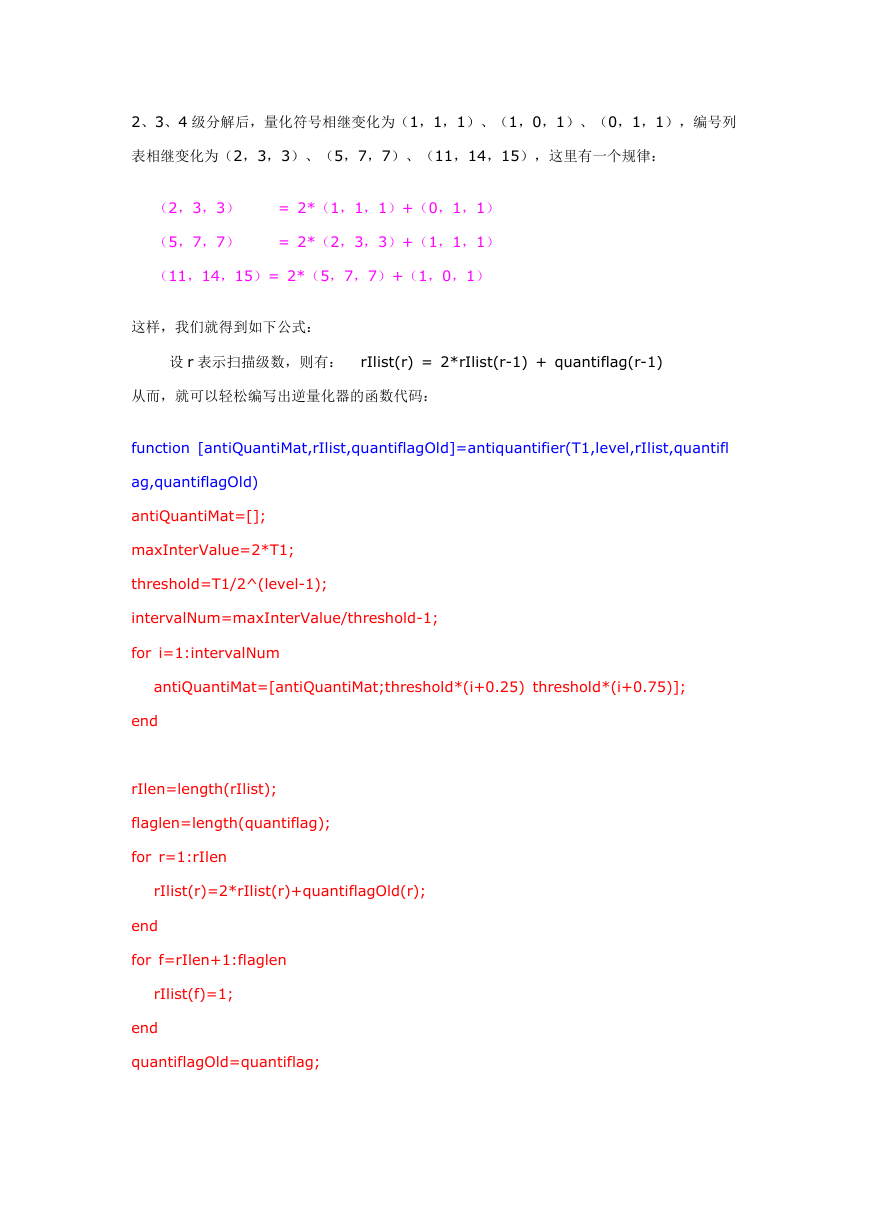

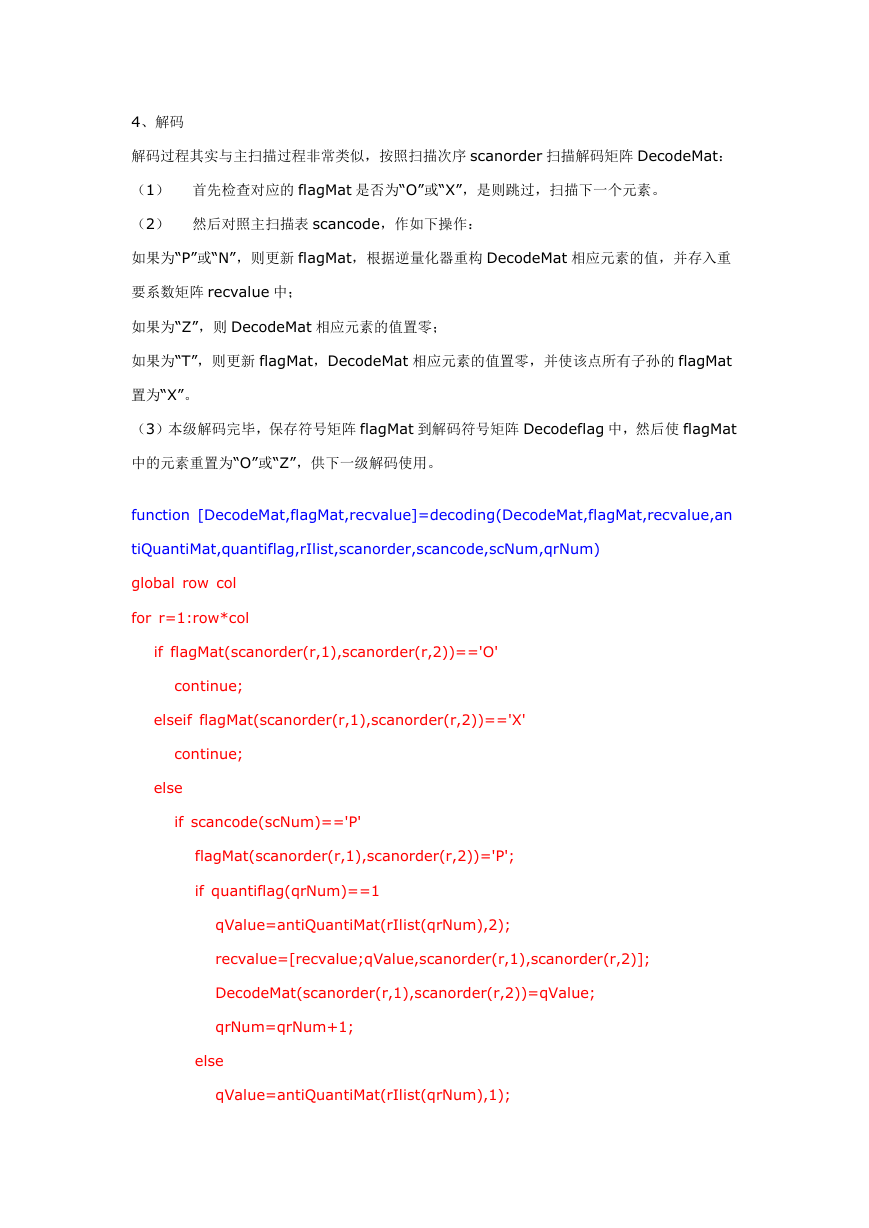
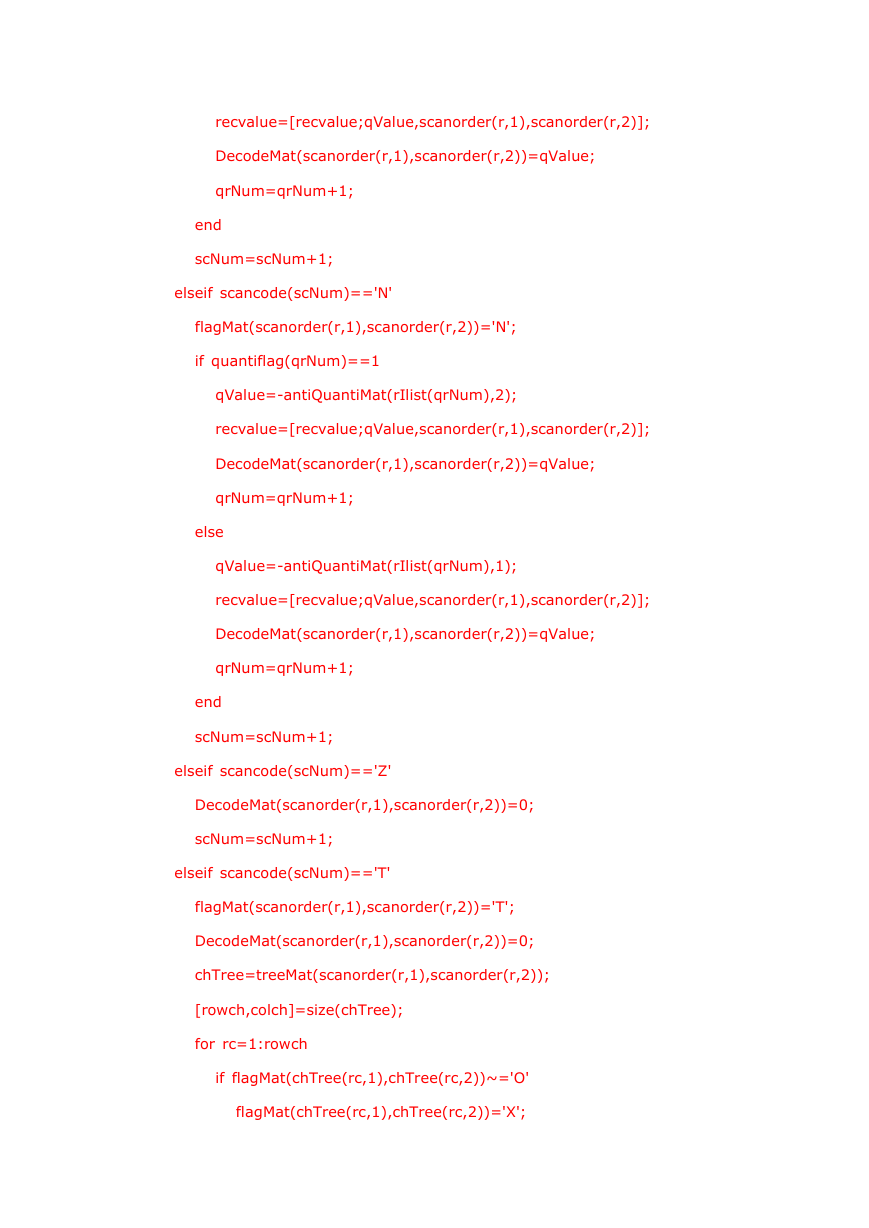
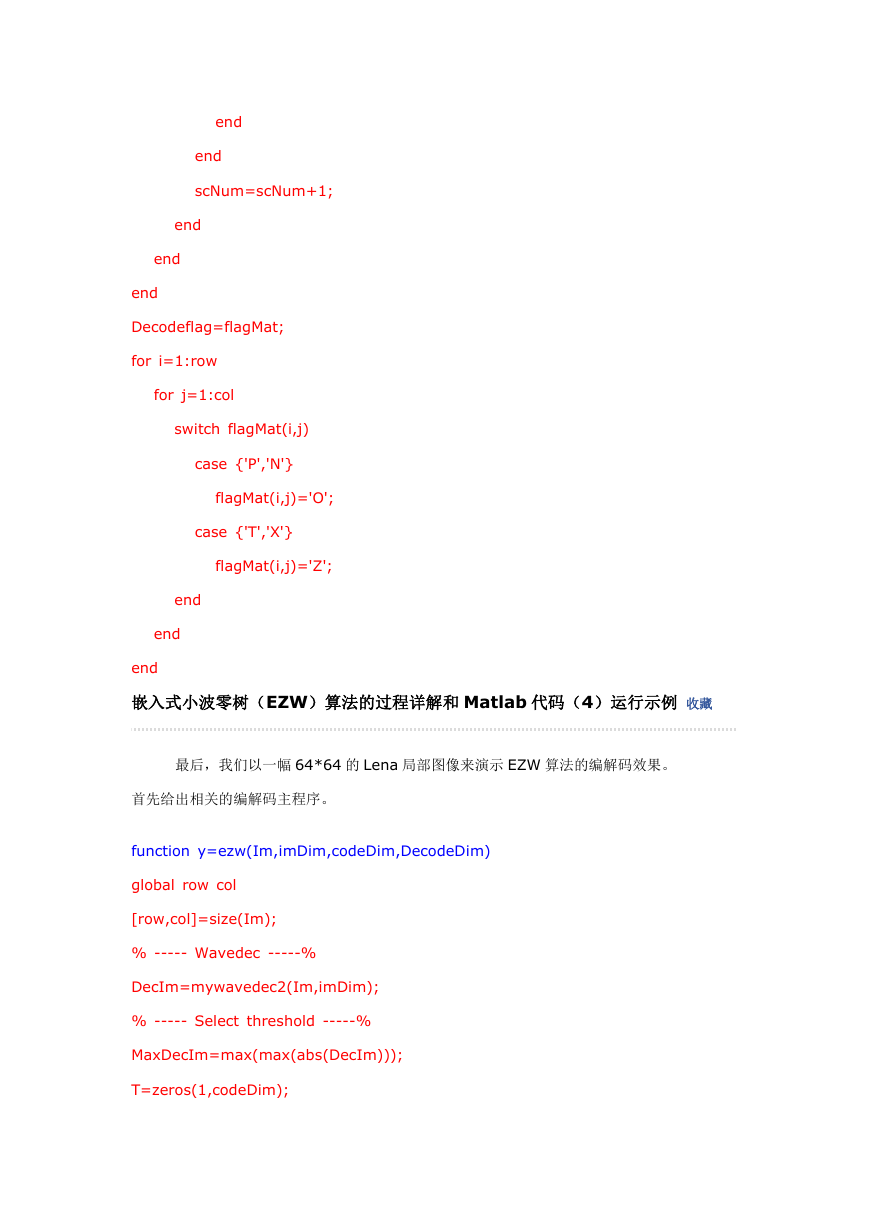
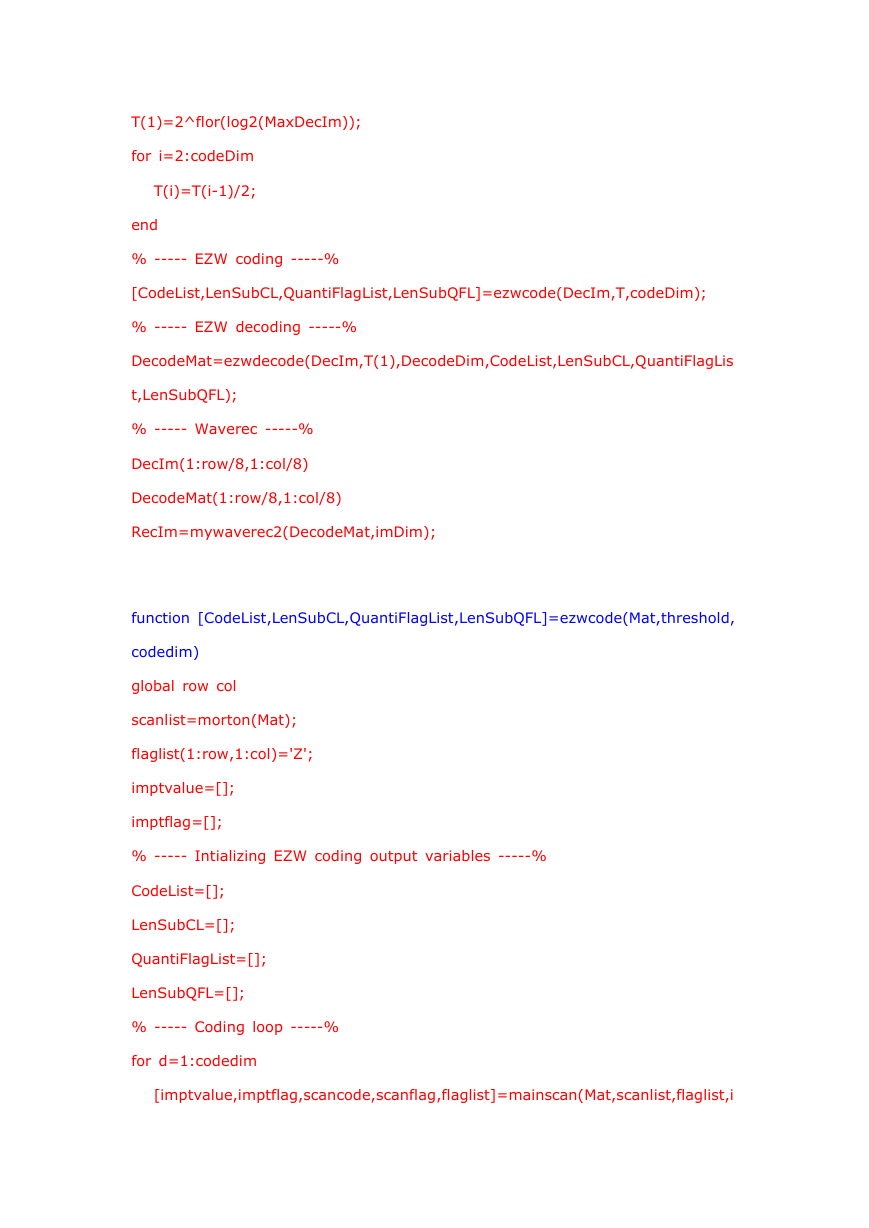









 2023年江西萍乡中考道德与法治真题及答案.doc
2023年江西萍乡中考道德与法治真题及答案.doc 2012年重庆南川中考生物真题及答案.doc
2012年重庆南川中考生物真题及答案.doc 2013年江西师范大学地理学综合及文艺理论基础考研真题.doc
2013年江西师范大学地理学综合及文艺理论基础考研真题.doc 2020年四川甘孜小升初语文真题及答案I卷.doc
2020年四川甘孜小升初语文真题及答案I卷.doc 2020年注册岩土工程师专业基础考试真题及答案.doc
2020年注册岩土工程师专业基础考试真题及答案.doc 2023-2024学年福建省厦门市九年级上学期数学月考试题及答案.doc
2023-2024学年福建省厦门市九年级上学期数学月考试题及答案.doc 2021-2022学年辽宁省沈阳市大东区九年级上学期语文期末试题及答案.doc
2021-2022学年辽宁省沈阳市大东区九年级上学期语文期末试题及答案.doc 2022-2023学年北京东城区初三第一学期物理期末试卷及答案.doc
2022-2023学年北京东城区初三第一学期物理期末试卷及答案.doc 2018上半年江西教师资格初中地理学科知识与教学能力真题及答案.doc
2018上半年江西教师资格初中地理学科知识与教学能力真题及答案.doc 2012年河北国家公务员申论考试真题及答案-省级.doc
2012年河北国家公务员申论考试真题及答案-省级.doc 2020-2021学年江苏省扬州市江都区邵樊片九年级上学期数学第一次质量检测试题及答案.doc
2020-2021学年江苏省扬州市江都区邵樊片九年级上学期数学第一次质量检测试题及答案.doc 2022下半年黑龙江教师资格证中学综合素质真题及答案.doc
2022下半年黑龙江教师资格证中学综合素质真题及答案.doc